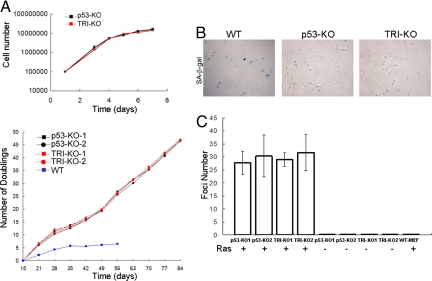Fig. 4.
Analyses of p53-KO and TRI-KO fibroblasts for growth, immortalization, senescence, and malignant transformation properties. (A) (Upper) Growth kinetics of the fibroblasts. Cells were seeded into 6-well plates and counted after incubation for the indicated times. (Lower) Long-term cumulative population doubling assay for fibroblasts were determined using cells passaged every 3–4 days. Cells were seeded into 6-well plates and counted after 48 h. Population doublings were calculated at different passages and plotted. Fibroblasts from a wild-type mouse were maintained for at least 8 passages without any overt immortalization. (B) Senescence-associated β galactosidase staining (blue) of fibroblasts at late passages (passage 25 for p53-KO and TRI-KO). Wild-type skin fibroblasts (passage 8) from an age-matched mouse were used as a positive control. (C) Ras-induced oncogenic transformation. Fibroblasts from 2 p53-KO mice (p53-KO1 and p53-KO2) and 2 triple mutant mice (TRI-KO1 and TRI-KO2) were transfected with Ras pT24+pEGFP.N1 (+) or pEGFP.N1 (-), and colonies were counted after 19 days. Colony numbers were adjusted to transfection efficiencies, which were quite similar for p53-KO and TRI-KO fibroblasts. WT-MEF, wild-type mouse embryonic fibroblasts were used as a negative control. Bars indicate standard errors of the mean.

